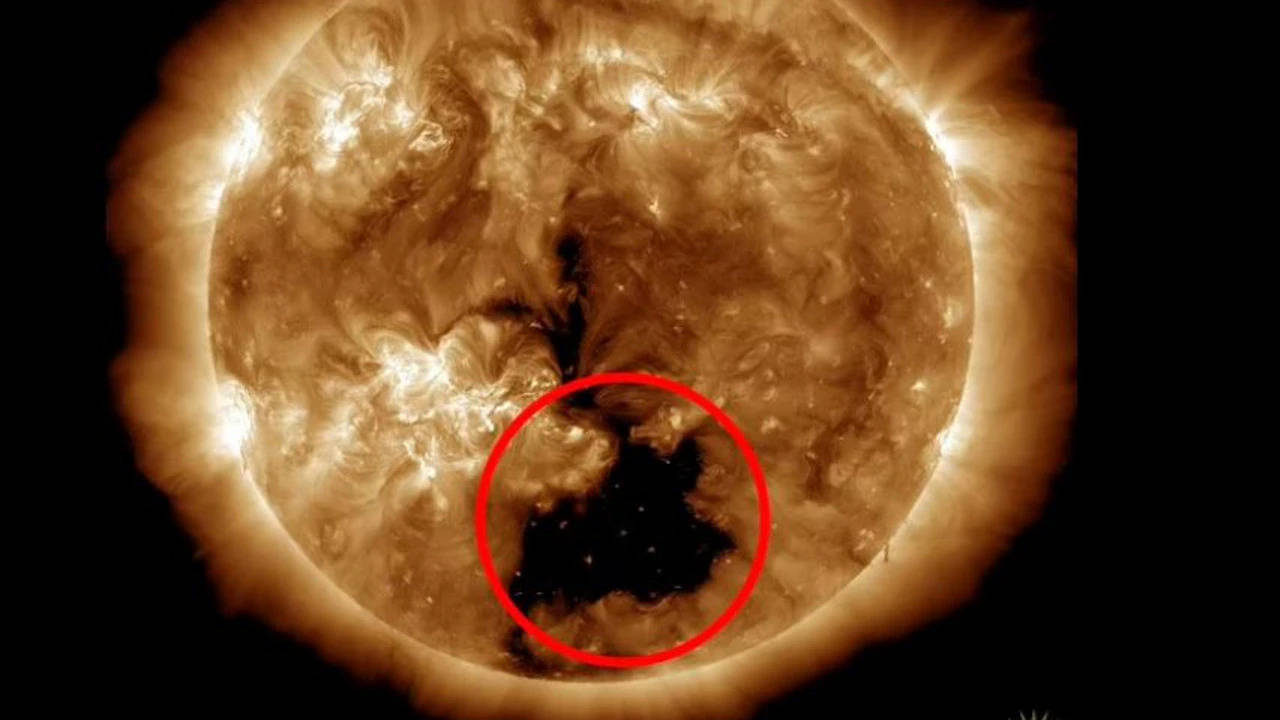In a remarkable celestial event, an enormous dark hole has opened up in the sun‘s surface, emitting powerful streams of unusually fast radiation, identified as solar wind, directly towards Earth, reported Live Science. The extraordinary size and orientation of this temporary gap, surpassing the width of 60 Earths, have puzzled scientists, particularly given its occurrence during the current stage of the solar cycle.
The vast dark region, recognized as a coronal hole, formed near the sun’s equator on December 2 and rapidly expanded to a maximum width of approximately 497,000 miles (800,000 kilometers) within 24 hours, according to Spaceweather.com.Since December 4, this solar void has been directly aligned with Earth.
Coronal holes materialize when the sun’s magnetic fields abruptly open up, leading to the release of solar wind from the sun’s upper surface, as explained by the National Oceanic and Atmospheric Administration (NOAA). These holes manifest as dark patches due to their cooler and less dense nature compared to the surrounding plasma, similar to the appearance of sunspots, though coronal holes are only visible in ultraviolet light.
The radiation emitted from coronal holes, characterized by higher speeds than normal solar wind, often triggers disturbances in Earth’s magnetic shield, resulting in geomagnetic storms, according to NOAA. The most recent coronal hole, appearing in March, generated the most powerful geomagnetic storm to impact Earth in over six years.
Initial predictions suggested that the current coronal hole could incite a moderate (G2) geomagnetic storm, potentially causing radio blackouts and vibrant auroral displays in the coming days. However, the intensity of the solar wind has been less than anticipated, resulting in a weaker (G1) storm so far, notes Spaceweather.com. Nonetheless, the possibility of auroras persists.
While the duration of the coronal hole’s presence remains uncertain, previous instances have seen such holes persist for more than a single solar rotation (27 days), according to NOAA. Nevertheless, the hole is expected to rotate away from Earth in the near future.
The recent surge in solar activity, contrary to expectations for the approaching solar maximum, raises intriguing questions. Typically, coronal holes are more common during solar minimum, and when they do emerge during solar maximum, they are usually located near the sun’s poles rather than the equator.
In the past weeks, various indicators, including a massive “sunspot archipelago,” solar storms, a “canyon of fire” eruption, and a solar flare, all point towards heightened solar activity. Scientists, revising their solar cycle forecasts in October, now anticipate the explosive peak to commence in early 2024, marking a significant turn in solar behavior.
The vast dark region, recognized as a coronal hole, formed near the sun’s equator on December 2 and rapidly expanded to a maximum width of approximately 497,000 miles (800,000 kilometers) within 24 hours, according to Spaceweather.com.Since December 4, this solar void has been directly aligned with Earth.
Coronal holes materialize when the sun’s magnetic fields abruptly open up, leading to the release of solar wind from the sun’s upper surface, as explained by the National Oceanic and Atmospheric Administration (NOAA). These holes manifest as dark patches due to their cooler and less dense nature compared to the surrounding plasma, similar to the appearance of sunspots, though coronal holes are only visible in ultraviolet light.
The radiation emitted from coronal holes, characterized by higher speeds than normal solar wind, often triggers disturbances in Earth’s magnetic shield, resulting in geomagnetic storms, according to NOAA. The most recent coronal hole, appearing in March, generated the most powerful geomagnetic storm to impact Earth in over six years.
Initial predictions suggested that the current coronal hole could incite a moderate (G2) geomagnetic storm, potentially causing radio blackouts and vibrant auroral displays in the coming days. However, the intensity of the solar wind has been less than anticipated, resulting in a weaker (G1) storm so far, notes Spaceweather.com. Nonetheless, the possibility of auroras persists.
While the duration of the coronal hole’s presence remains uncertain, previous instances have seen such holes persist for more than a single solar rotation (27 days), according to NOAA. Nevertheless, the hole is expected to rotate away from Earth in the near future.
The recent surge in solar activity, contrary to expectations for the approaching solar maximum, raises intriguing questions. Typically, coronal holes are more common during solar minimum, and when they do emerge during solar maximum, they are usually located near the sun’s poles rather than the equator.
In the past weeks, various indicators, including a massive “sunspot archipelago,” solar storms, a “canyon of fire” eruption, and a solar flare, all point towards heightened solar activity. Scientists, revising their solar cycle forecasts in October, now anticipate the explosive peak to commence in early 2024, marking a significant turn in solar behavior.
Denial of responsibility! News Continue is an automatic aggregator of the all world’s media. In each content, the hyperlink to the primary source is specified. All trademarks belong to their rightful owners, all materials to their authors. If you are the owner of the content and do not want us to publish your materials, please contact us by email – [email protected]. The content will be deleted within 24 hours.


